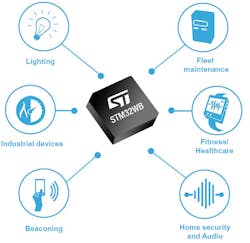A Different Way to Deliver Advanced IoT Applications
Download this article in PDF format.
When preparing to start a new advanced IoT design, where do you begin? Do you start with a microcontroller or a radio? Most single-chip IoT devices are an MCU combined with a wireless transceiver. Or is that wireless transceiver packaged with a support MCU? It could be either—it all depends on how you view the project. In any case, with all of the single-chip IoT devices available, it’s difficult to decide.
However, some demanding IoT products need major computing power and a low-power, long-range radio. Such a prime combination requirement helps narrow down what ICs are available to handle the job. However, this article introduces a new choice you may not know you had.
Sponsored Resources:
- STM32WB Wireless Series MCUs with Bluetooth™ 5 & IEEE 802.15.4
- STM32WB Dual-Core Wireless MCUs from STMicroelectronics Deliver Ultra-Low-Power Real-Time Performance
- How to Develop with the STM32WB
Know Your IoT Radios
One of your biggest design decisions is which of the dozen or so wireless technologies do you select? Here’s a quickie list to refresh your knowledge:
- Wi-Fi: Used mostly in gateways and routers, Wi-Fi is overkill for some projects. Its high speed and higher power consumption make it unsuitable for many applications that need remote battery-powered sensors.
- Bluetooth: A good fit with many IoT applications. Its low-power version and reasonable data rate make it a solid choice for many applications. It uses frequency-hopping spread spectrum (FHSS) with GMSK modulation in the 2.4-GHz band and a 1- or 2-Mb/s data rate. Multiple networking configurations are available.
- IEEE 802.15.4: This radio standard has been around for some time and is widely used in some proprietary designs. It’s also the basis for other several IoT standards. It uses direct sequence spread spectrum (DSSS) in the 2.4-GHz band with a maximum data rate of 250 kb/s.
- Zigbee: One of the standards based on 802.15.4. It adds its own network and applications stack that implements a mesh-networking feature. Zigbee is widely used in industry and home wireless applications.
- Thread: This standard is built on the 802.15.4 base but incorporates 6LoWPAN—the standard that encapsulates and compresses IPv6 internet access packets over 802.15.4 wireless networks.
- Z-Wave: A proprietary standard that operates on 908.42 MHz with FSK at a rate up to 40 kb/s. It’s used mostly in home networks and consumer IoT.
- LoRa: Another proprietary standard that uses a unique FM chirp spread-spectrum-type modulation method to achieve very long range at low power at 915 MHz.
- NB-IoT and LTE-M: Short-range standards taking advantage of the LTE cellular networks with data rates up to 1 Mb/s.
You may want to begin exploring the microcontroller/wireless transceivers available to help you make a decision. All of the main IoT technologies listed above work just fine and have an impressive base. The choice may come down to the SoC ICs that can meet your needs.
Introduction to the STM32WB
The STM32WB is a new dual-core wireless MCU developed by STMicroelectronics (Fig. 1). Yes, dual cores, an Arm Cortex-M0+ to control the radio, and an Arm-Cortex-M4 to implement the application firmware and peripherals. This powerful combo makes the device flexible to handle almost any application, especially those with more demanding needs. The MCU partition simplifies and helps speed development. And the MCU pair permits real-time execution, something you can’t usually get with other devices.
1. The STM32WB dual-core wireless microcontroller can handle a range of IoT applications, particularly those with tough-to-meet requirements.
As for the radios, the operating frequency is the 2.4-GHz band. This SoC supports Bluetooth 5 with its low power consumption and new mesh-networking capability. It also supports IEEE 802.15.4 and its spinoffs Zigbee and Thread. The receive sensitivity is −96 dBm and the power output is 6 dBm for a total link budget of 102 dB. The STM32WB operates from a 1.7- to 3.6-V dc supply with very low power consumption over the temperature range of −40 to 105°C.
As for I/O, the STM32WB includes all of the usual interfaces including I2C (2), USART, LP-UART, SPI (2), and USB 2.0 FS. The STM32WB comes with different amounts of memory and different package sizes. A hardware development pack greatly facilitates testing, evaluating, and prototyping (Fig. 2).
2. One of ST Micro’s development boards for the STM32WB.
What About the Software?
IoT products and applications tend to be more software-intensive than hardware. The STM32WB solves the hardware problem and ST’s accompanying software suite helps facilitate IoT development. The development software for the STM32WB is designated the STM32CubeWB package. It includes the STM32Cube HAL and low-layer (LL) API peripheral drivers, a set of middleware components (RTOS, USB, FatFS, and STM32 touch sensing), as well as Bluetooth Low Energy (BLE) and Thread connectivity stacks. All embedded software utilities come with a full set of examples running on STMicro boards.
Another software tool is the STM32CubeMX package that enables faster development thanks to its MCU pinout and clock configurator, power-consumption calculator, and code-generation tools. An Eclipse plug-in (STSW-STM32095) is also available. In addition, there’s the STM32CubeMonRF—a development tool dedicated to wireless connectivity—that handles radio testing and beaconing to hasten time to market.
STMicroelectronics also offers the MLPF-WB55-01E3, an accessory that integrates an impedance-matching network and harmonics filter. The matching impedance network has been tailored to maximize the RF performance of STM32WB55xx.
The P-NUCLEO-WB55 pack provides two boards containing STM32WB that let you test multiple configurations. The companion STM32CubeWB software contains the HAL, lower-level APIs, middleware, Bluetooth 5 Open-Thread certified stacks. Also, you can install ST’s STM32CubeMX graphical configuration tool supporting pinout, code generation, and power optimization, with provided examples or user projects.
If you haven’t considered ST microcontrollers before, take a look at this one—it’s a unique and a flexible solution to many advanced IoT opportunities.
Sponsored Resources:



